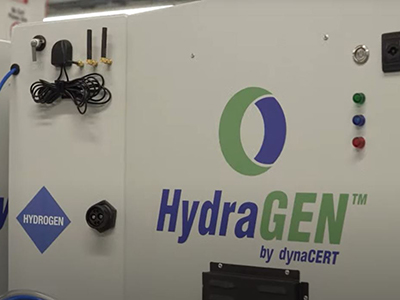
DynaCERT Inc. says its HydraGEN technology has the capability to significantly reduce carbon emissions and fuel costs for vehicle fleets, as proven by its pilot program with Alectra Utilities Corporation.
HydraGEN is used in an engine to create hydrogen and oxygen gases through electrolysis at the point of combustion, resulting in lower emissions and savings on fuel. The only extra ingredient is distilled water.
In 2021, Alectra instituted a six-month pilot program using HydraGEN in 13 of its vehicles. The results showed savings of over 8,000 kgs of carbon dioxide equivalent (CO2e); each vehicle reduced diesel consumption by 230 litres on average.
"Alectra Utilities is one of several utility companies. They were the first of the utility companies that took an interest in this," said Jim Payne, DynaCERT's president and CEO. "We've now got several municipalities that are just finalizing their pilot projects, where there's going to be a lot of analysis over the next quarter."
The program showed Alectra could reduce its carbon emissions and fuel costs by over 10 per cent based on the 2021 data of its entire fleet.
HydraGEN, which is available in several models, is designed for use in trucks ranging from Class 2 to Class 8, refrigeration units, power generators, marine vessels, construction equipment, mining and forestry equipment as well as locomotives.
Alectra recently received the Most Innovative Leader Award from the Windfall Ecology Centre for its use of DynaCERT's patented technology in its fleet vehicles.
Mississauga-based Alectra, which serves more than one million homes and businesses in Ontario’s Greater Golden Horseshoe, is the largest municipally-owned electric utility in Canada by customer base.
The Windfall Centre is an Aurora, Ont.-based non-profit focused on sustainable communities.
DynaCERT's HydraGEN technology
DynaCERT (DYA-T), founded in 2001, patented the first version of HydraGEN in 2010. Headquartered in Toronto with an over-20,000 square foot office, research and development facility, its technology is deployed in over 50 countries. That facility can produce 72,000 HydraGEN units per year.
It also has European sales offices in Germany under DynaCERT GmbH.
"Since then, our product has advanced so much. It not even remotely looks like what it did back in those days," Payne said. "The technology we have today is so far advanced, it's fully computerized."
He said the company has invested over $90 million since its inception on research and development.
HydraGEN in its current form was fully commercialized a little over three years ago, with the company aggressively marketing it mere weeks before the COVID-19 pandemic began.
According to third-party verification performed by PIT Group in Montreal and performance testing at Continental EMITEC in Germany, HydraGEN results in six to 19 per cent lower fuel consumption when outfitted to an internal combustion engine.
It also showed an up-to-88 per cent reduction in nitrous oxides, 51 per cent reduction of carbon monoxides, 50 per cent reduction in hydrocarbons and up-to-65 per cent reduction in particulate matter.
"What we know, what has been proven for over 50 years, is that the introduction of hydrogen to an internal combustion engine enhances the burn," Payne said.
The company also developed an app, available on Android and iOS, that allows users to track emissions and fuel savings data.
The future of HydraGEN
Today, the company holds over 20 patents, including one for monitoring and monetizing carbon credits within an internal combustion engine.
According to Payne, the company has spent the past two-and-a-half years going through the certification process with Verra, the world's largest voluntary program for certification of greenhouse gas emissions reductions projects. He said DynaCERT's methodology is in the final stages of an audit from Earthood and is expected to be certified in the fourth quarter of this year.
It will be a shared carbon credit, meaning DynaCERT and the end-user will split the credit with 50 per cent each. Payne stated the average long-haul truck could generate up to $3,000 in carbon credits.
In the mining industry, DynaCERT is active in Australia, Chile, Brazil and other countries. While HydraGEN can be applied to a number of different vehicles, the current goal is to establish the technology in large container ships.
"Our goal is to get into the large ships. We just got the first couple of projects going in the rail side, but the large shipping container ships is where we really want to get," he said. "You'll look at one container ship, it's putting up the equivalent of 100 million cars per year in pollution."










